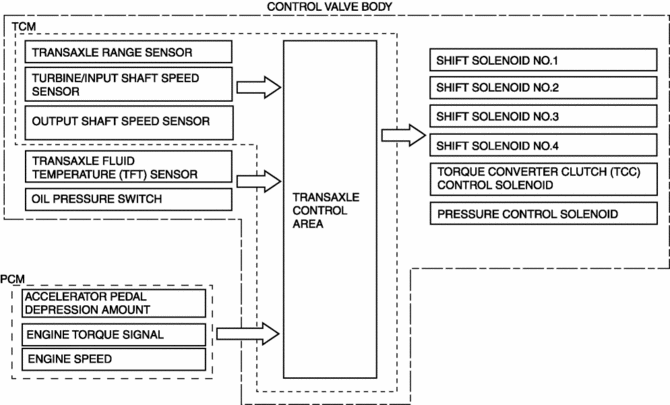Mazda CX-5 Service & Repair Manual: Shift Pressure Control (Direct Electric Shift Control) [Fw6 A EL, Fw6 Ax EL]
Outline
-
The TCM drives shift solenoids No.1, 2, 3, 4, the pressure control solenoid, and the on/off solenoid based on inputs signals from each switch and sensor, and performs direct electronic control of the clutch engagement pressure. As a result, precise hydraulic pressure control of the clutch engagement, not possible using a conventional accumulator, is achieved.
Construction

Operation
N to D, and N to R selected
-
When N to D, and N to R are selected, the TCM drives the pressure control solenoid and shift solenoids No. 1 and 3 for optimum clutch engagement pressure control.
Shifting
-
During shifting, the TCM drives shift solenoids No.1, 2, 3, and 4 to directly control the clutch engagement pressure for optimum clutch engagement pressure control.
-
During each gear shift, the engagement side clutch pressure and release side clutch pressure are controlled simultaneously. As a result, the torque capacities of both clutches can be controlled in connection to each other when switching clutches, engine over-speed during shifting and interlock among clutches is prevented, and smooth and responsive shifting is achieved.
 Shift Lock System [Fw6 A EL, Fw6 Ax EL]
Shift Lock System [Fw6 A EL, Fw6 Ax EL]
Purpose, Function
The shift-lock system operates when the ignition is switched to ON and the
brake pedal is not depressed, and inhibits the selector lever from being shifted
from the P po ...
 Shift Pressure Control (Learning Control) [Fw6 A EL, Fw6 Ax EL]
Shift Pressure Control (Learning Control) [Fw6 A EL, Fw6 Ax EL]
Outline
The TCM optimizes the hydraulic pressure for clutch engagement and disengagement
through learning correction of the clutch engagement pressure.
NOTE:
The clutch engagem ...
Other materials:
Camshaft Position (CMP) Sensor Inspection
Intake CMP Sensor
Visual inspection
CAUTION:
When replacing the CMP sensor, make sure there is no foreign material on
it such as metal shavings. If it is installed with foreign material, the sensor
output signal will malfunction resulting from fluctuation in magnetic flux and
caus ...
Steering Wheel And Column Inspection
Play inspection
1. With the wheels in the straight-ahead position, start the engine.
2. Turn the steering wheel to the left and right gently, then verify that the
steering wheel play is within the specification.
Steering wheel play
0—30 mm {0—1.1 in}
Looseness, Exces ...
Refrigerant System Service Cautions
Handling Insufficient Refrigerant Level
If an insufficient refrigerant level is detected at troubleshooting, do
not charge (add) the refrigerant. Because an accurate amount of refrigerant
cannot be determined from the pressure indicated on the manifold gauge, never
charge the refrige ...
